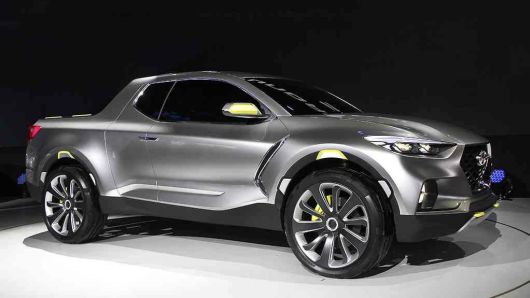Light trucks now account for two-thirds of the U.S. new vehicle market, and while utility vehicles might dominate the American market, demand also is booming for pickups, something planners at Hyundai soon hope to tap into.
The Korean car maker expects a production version of the Santa Cruz will launch in the U.S. market in 2020 or sometime the following year. The Santa Cruz pickup concept was revealed at the January 2015 North American International Auto Show in Detroit. Originally intended as little more than a styling exercise, the compact pickup will become a central part of the push by Hyundai to expand its presence in the booming U.S. light truck market.
Targeting what it has described as “Urban Adventurers,” the production Santa Cruz is expected to be the lone entry into the compact pickup segment that effectively disappeared several decades ago, in part due to hefty tariffs on imported trucks. Hyundai will still face those challenges, and potentially a rival from Ford.
“We just had a meeting to look at the design,” Kyung Soo “Ken” Lee, Hyundai Motor America’s CEO said in an interview during the preview of another critical entry in its truck line-up, the complete makeover of its Santa Fe crossover-utility vehicle.
SUVs and CUVs get most of the attention, but pickups make up a critical – and highly profitable – segment of the American automotive market. The full-size Ford F-Series, Chevrolet Silverado and Ram 1500 models have for years been the market’s three best-selling product lines, in that order. And written off for dead just a few years ago, the midsize pickup segment has come roaring back since mid-decade.
Where Subaru’s BRAT stumbled
Back in the 1960s and 1970s, small pickups, such as the Subaru BRAT, found a niche with baby boomers on a budget who were just getting their licenses and wanted something different from the sedans and wagons their parents drove. They were more likely to be based on car-like platforms – just like today’s crossovers – the BRAT sharing its underpinnings with a small Subaru station wagon.
That’s the approach Hyundai will take, though Lee and other Hyundai officials are being intentionally vague about details.
One of the key questions yet to be revealed is whether the production version of the Santa Cruz will feature the same, unique bed extender that was a key part of the show car’s appeal. The unusual system worked something like a drawer, allowing the bed to slide back to add extra length for large cargo. Fully extended, a motorcycle could fit into it. Retracted, the Santa Cruz concept was only about as long as a typical concept sedan.
Though it will have more flexibility than a similarly sized utility vehicle, Hyundai isn’t planning to bill the production Santa Cruz as a work truck, but will target millennials and even younger Gen-Z buyers who, much like the then-young boomers, wanted something a bit different and more affordable.
That could mean a starting price in the teens, undercutting the current base model among midsize trucks, the Nissan Frontier, which starts at around $18,000.
Full-size pickups are some of the most profitable vehicles sold in the U.S., and midsize models are generally delivering good margins, according to industry data. But at the likely price for the Santa Cruz, margins likely will be much tighter.
‘Chicken tax’
So, one of the other unanswered questions is where Hyundai will produce the Santa Cruz. Import pickups have largely been priced out of the market because of the “chicken tax,” a 25 percent tariff holdover from a trade battle between the U.S. and several European countries back in the mid-1960s. That would likely make it impossible to bring the truck in from Korea.
The alternative would be to produce Santa Cruz at Hyundai’s sole U.S. assembly plant in Alabama. The carmaker might also try to squeeze the truck into one of the plants operated by its Korean sibling, Kia, one in Georgia, the other in Mexico. Unless NAFTA is rewritten or scrapped, as President Donald Trump has threatened, trucks built there don’t pay the chicken tax.
While Hyundai is still studying the potential demand for the Santa Cruz, the truck will become part of the brand’s broader shift into light trucks. It has lagged behind key U.S. and Asian competitors in adapting to this trend, noted Mike O’Brien, its top U.S. product planner.
Utility vehicles, pickups, vans and other models now account for 68.6 percent of the American new vehicle market, with Hyundai’s light truck share only at 43.5 percent. The automaker is also expanding and updating its crossover line-up to gain momentum.
As it tries to gain a foothold, other automakers are stepping up their efforts as well. Ford Motor will early next year relaunch the midsize Range nameplate that has been absent from the American market since 2011.
Several recent news reports have indicated the Detroit automaker is also studying opportunities for an even smaller entry, likely car-based, that could come to market sometime during the first half of the coming decade. If that happens, there will be more competition for the Santa Cruz.

